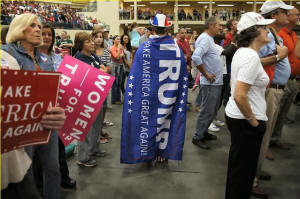|
Tough reality check for Trump's pledge of
better heartland jobs, wages
 Send a link to a friend
Send a link to a friend
 [November 10, 2016]
By Howard Schneider [November 10, 2016]
By Howard Schneider
CHARLOTTE, North Carolina - Donald Trump's
promise to revive small town America faces a tough challenge in an
economy that for decades has been wired to direct income and
opportunities towards urban hubs and the better educated.
Little in the president-elect's so far sketchy economic plans indicates
the trend can be reversed any time soon, according to interviews with
experts on income inequality and as recent occupational trends.
The manufacturing jobs Trump pledges to bring back have disappeared as
much because of automation as the trade deals he has promised to
rewrite, and that process will only continue. A promised infrastructure
revamp would boost middle wage jobs but for only as long as the programs
last, economists point out.
During President Barack Obama's eight years in office incomes for the
best off continued to diverge, despite nearly 10 million new jobs and
recent strength in those paying middle-tier wages.
On a pre-tax basis, the share of income to the top fifth of households
increased from 50.4 percent to 51.4 percent between 2008 and 2015 at the
expense of all the others, according to census estimates.
(Graphic:http://tmsnrt.rs/2elimH2)
Without the sort of tax and redistribution policies Republicans have
traditionally opposed, Trump may struggle to make good on his promise to
help those left behind in the global economy, economists who study
inequality trends say.

"We have 30 to 40 years to catch up on...Lots of money has gone to the
top and to change that is going to be a long and slow process," said
David Madland, a senior fellow at the Center for American Progress, a
think tank with close ties to Democratic nominee Hillary Clinton's
campaign.
Trump campaigned promising to shake up a Washington establishment he
argued was responsible for destroying middle class jobs with bad trade
deals. The message hit home across rural America and mid-sized cities,
where voters felt they missed out on the fruits of the seven-year
economic recovery that big cities may have enjoyed.
Charlotte has been growing fast as a financial hub that attracts college
educated talent from around the country, and Democratic nominee Hillary
Clinton did better there than Obama did in 2012, handily beating Trump
by 137,000 votes.
But in the state's textile and furniture belt just northwest from here,
Trump's promise of economic renewal and anxieties of a shrinking white
majority more than offset Clinton's urban victory, giving him 76 out of
100 North Carolina's counties.
The Catawaba County region, one of the nation's hardest-hit by cheap
imports from China, now has a more diverse economy and even the
furniture industry has begun adding jobs. But many still live in poverty
and rely on disability and social services for support.
"The trade argument was as prominent as any. That is certainly the bet
that the Trump campaign has made," said
[to top of second column] |

A supporter of Republican presidential nominee Donald Trump is
pictured during a campaign event in Concord, North Carolina, U.S.
November 3, 2016. REUTERS/Carlo Allegri

John Dinan, a political scientist at Wake Forest University.
TAKING OUT OBAMACARE
Trump has not highlighted income inequality the way Clinton did, but
to help low-wage industries such as textiles or offer a "new deal"
for blacks, he would need to tackle the income gap.
Recent data show how hard it may be if Trump relies on economic
growth alone: Despite a record jump in household income and a
continued surge in middle wage jobs nationally, the effect on income
inequality was "statistically insignificant" according to census
estimates.
Under Obama, after tax income for the bottom fifth of households did
increase by about 18 percent, or $2,200, according to a recent
Council of Economic Advisers study.
But that was made possible by higher taxes on the wealthy, more
benefits for the poor and, in large part, by an estimated $1,900
gain from health coverage extended under the Affordable Care Act.
Trump has vowed to roll Obamacare back.
Instead, Trump has proposed to strike better trade deals and offered
a familiar Republican recipe - tax cuts for businesses meant to spur
investment and jobs. He has been ambiguous about a possible increase
in the federal minimum wage typically opposed by Republicans, but
advocated by many economists as a way to help the disenfranchised
workers Trump focused on in his campaign.
Economists say that even if economic growth accelerates under Trump,
it may not do much to counter the downward pressures on wages and
middle income jobs from automation, technology and other
longstanding trends.
Brookings Institution senior fellow Isabel V. Sawhill said
researchers on inequality agree on one point: it is hard to move the
needle.

"Even when you distribute all of the dividends from growth in a
progressive fashion you donít change things very much," Sawhill
said. "You shift things at the margin."
(Reporting by Howard Schneider; Editing by David Chance and Tomasz
Janowski)
[© 2016 Thomson Reuters. All rights
reserved.]
Copyright 2016 Reuters. All rights reserved. This material may not be published,
broadcast, rewritten or redistributed. |